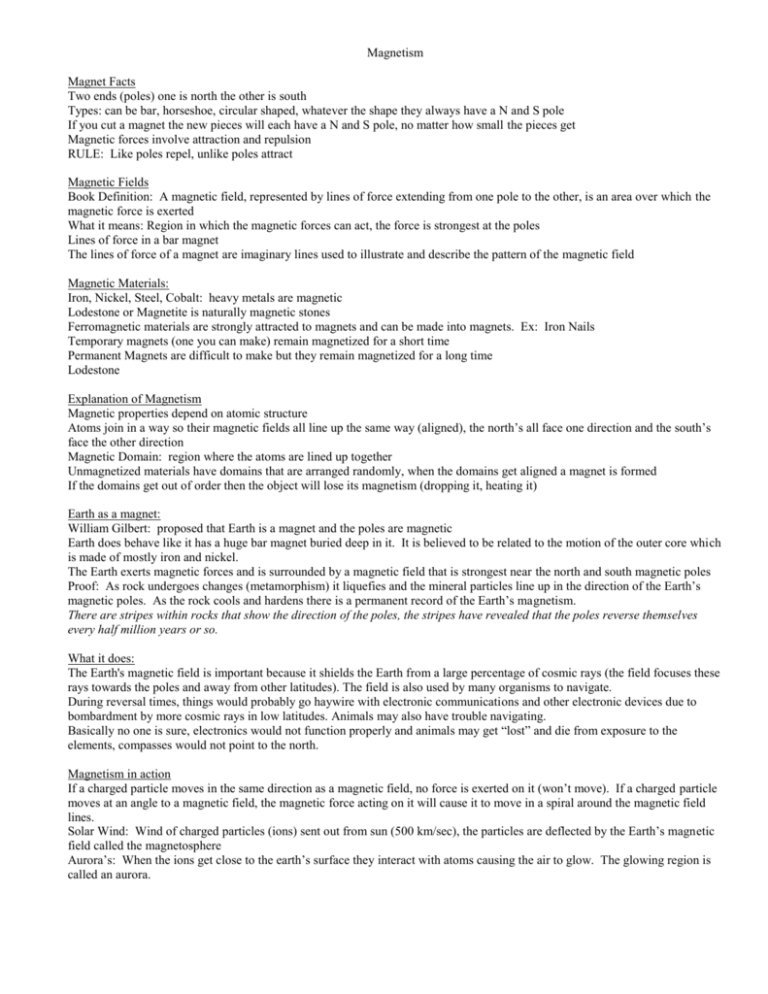Magnetism Full Notes
advertisement

Magnetism Magnet Facts Two ends (poles) one is north the other is south Types: can be bar, horseshoe, circular shaped, whatever the shape they always have a N and S pole If you cut a magnet the new pieces will each have a N and S pole, no matter how small the pieces get Magnetic forces involve attraction and repulsion RULE: Like poles repel, unlike poles attract Magnetic Fields Book Definition: A magnetic field, represented by lines of force extending from one pole to the other, is an area over which the magnetic force is exerted What it means: Region in which the magnetic forces can act, the force is strongest at the poles Lines of force in a bar magnet The lines of force of a magnet are imaginary lines used to illustrate and describe the pattern of the magnetic field Magnetic Materials: Iron, Nickel, Steel, Cobalt: heavy metals are magnetic Lodestone or Magnetite is naturally magnetic stones Ferromagnetic materials are strongly attracted to magnets and can be made into magnets. Ex: Iron Nails Temporary magnets (one you can make) remain magnetized for a short time Permanent Magnets are difficult to make but they remain magnetized for a long time Lodestone Explanation of Magnetism Magnetic properties depend on atomic structure Atoms join in a way so their magnetic fields all line up the same way (aligned), the north’s all face one direction and the south’s face the other direction Magnetic Domain: region where the atoms are lined up together Unmagnetized materials have domains that are arranged randomly, when the domains get aligned a magnet is formed If the domains get out of order then the object will lose its magnetism (dropping it, heating it) Earth as a magnet: William Gilbert: proposed that Earth is a magnet and the poles are magnetic Earth does behave like it has a huge bar magnet buried deep in it. It is believed to be related to the motion of the outer core which is made of mostly iron and nickel. The Earth exerts magnetic forces and is surrounded by a magnetic field that is strongest near the north and south magnetic poles Proof: As rock undergoes changes (metamorphism) it liquefies and the mineral particles line up in the direction of the Earth’s magnetic poles. As the rock cools and hardens there is a permanent record of the Earth’s magnetism. There are stripes within rocks that show the direction of the poles, the stripes have revealed that the poles reverse themselves every half million years or so. What it does: The Earth's magnetic field is important because it shields the Earth from a large percentage of cosmic rays (the field focuses these rays towards the poles and away from other latitudes). The field is also used by many organisms to navigate. During reversal times, things would probably go haywire with electronic communications and other electronic devices due to bombardment by more cosmic rays in low latitudes. Animals may also have trouble navigating. Basically no one is sure, electronics would not function properly and animals may get “lost” and die from exposure to the elements, compasses would not point to the north. Magnetism in action If a charged particle moves in the same direction as a magnetic field, no force is exerted on it (won’t move). If a charged particle moves at an angle to a magnetic field, the magnetic force acting on it will cause it to move in a spiral around the magnetic field lines. Solar Wind: Wind of charged particles (ions) sent out from sun (500 km/sec), the particles are deflected by the Earth’s magnetic field called the magnetosphere Aurora’s: When the ions get close to the earth’s surface they interact with atoms causing the air to glow. The glowing region is called an aurora.






